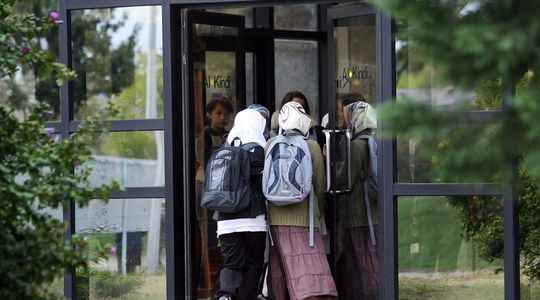The word is strong. On June 2, the newspaper Opinion denounced an “epidemic” of Islamic outfits at the gates of high schools, in particular abayas or kamis, these long tunics worn to the ankles. Based, among other things, on an alert from territorial intelligence to the Ministry of the Interior, and on feedback from several rectorates, the daily reported on various attempts to undermine secularism. The next day, President Emmanuel Macron, visiting Marseille, reacted to these revelations, demanding “clarity on all the figures”. “As in all matters, when there are epidemics, there must be symptoms and we measure, he insisted. The law is very clear: for all students in our schools, there is no there are no religious signs whatsoever (…) We are going with the Minister [NDLR : de l’Education, Pap Ndiaye]watch, measure and respond with the utmost clarity to all situations that do not respect the laws of the Republic.”
Jean-Pierre Obin, former Inspector General of National Education, believes that this alert deserves to be taken seriously. The author of the book How Islamism was allowed to penetrate the school (Hermann editions, 2020) looks back at the flaws in National Education in terms of respect for secularism in recent years.
The Express: Opinion recounts a multiplication of incidents around the wearing of certain Islamic outfits in schools in recent times. Does this revelation surprise you?
Jean-Pierre Obin: This finding is nothing new. Since the publication of the law of March 2004, which prohibits the wearing of ostentatious religious symbols at school, Muslim students have sought to circumvent this principle by demanding the display of bandanas, various head coverings, or other outfits, like the famous abayas, marking their allegiance to a certain politico-religious movement. Around this same time, the boys also began to attempt to wear what are now called kami and what used to be referred to as “Afghan outfits”. Now, is this type of phenomenon increasing? I think that the survey published this week deserves to be taken into consideration and to be confronted, as far as possible, with figures. But, faced with the recent development of attacks on secularism in classrooms on many other subjects, the report drawn up by this journalist seems to me quite credible.
The daily evokes a potentially “concerted” operation, or even the existence of challenges on social networks. Is there, behind, a desire to test the limits of the republican school?
Of course, let’s not forget that these practices are encouraged by militant organizations, essentially linked to that of the Muslim Brotherhood in my opinion. We saw this recently in Grenoble, through the affair of the authorization to wear the burkini in public swimming pools. It is certain that the way in which Jean-Luc Mélenchon flatters the communitarians and the Islamists today gives wings to the latter. The recent meetings of insubordinate France, which were accompanied by halal menus, fast-breaking celebrations at the time of Ramadan, had the effect of caressing these activists in the direction of the hair. Their offensive on society in general, and therefore also on the school – which, once again, is not new – can be strengthened. Especially since National Education has shown its flaws in recent years on this issue.
The principals confronted with the wearing of Islamic dress seem very divided today on the attitude to adopt. How do you explain it?
Several scenarios must be distinguished. Some headteachers or teachers interpret the law in their own way and act at the very least by saying to themselves “after all, it’s not that serious”. Others naively adhere to the argument of the Islamists which consists in saying that the approach of these students is not religious but cultural. A fallacious argument that should not deceive anyone! Finally, we cannot deny the existence of a form of complacency among certain personnel who could be taxed as Islamo-leftists. Without forgetting all those who, fortunately, camp on republican and secular values. Which is not always easy because some are not supported, or even dropped by their superiors in some cases.
Does this mean that this famous “no waves” regularly mentioned is still in force?
In my latest book, I give the example of this principal working in a high school located in the Paris region: when she took office in 2012, she found herself confronted with around thirty young veiled girls in her establishment. For three years, she will fight and carry out consultations with the mothers of these students to make the veils and other religious outfits disappear… Before being finally judged by her rectorate, which will force her to leave. Ten years later, the situation has not really improved. Even if former minister Jean-Michel Blanquer made it one of his hobbyhorses, this culture of “no waves” is still at work today.
Is the law clear enough? On the legal level, do school heads have all the cards in hand to be able to act?
Yes, the law relating to the prohibition of the wearing of ostentatious religious symbols is very clear. And the application circular published in May 2004 is even more so. The vademecum on secularism in schools, published by the ministry four years ago and regularly updated, is an additional tool. It refers in particular to two judgments rendered by the Council of State, and to another judgment of the Administrative Court of Appeal of Paris. Concretely, any sign is likely to manifest a religious affiliation. But, before qualifying it as such, it is important to study the context in which it takes place. Examples of signs that should be taken seriously: if there is a group demonstration, ie if several students arrive at middle school or high school dressed in the same way; if there is a desire for proselytism; if this behavior is accompanied by disputes in science or history lessons… Despite what some say, management personnel now have all the means to decide. It is still necessary that they have the courage, the will and that they feel supported.
